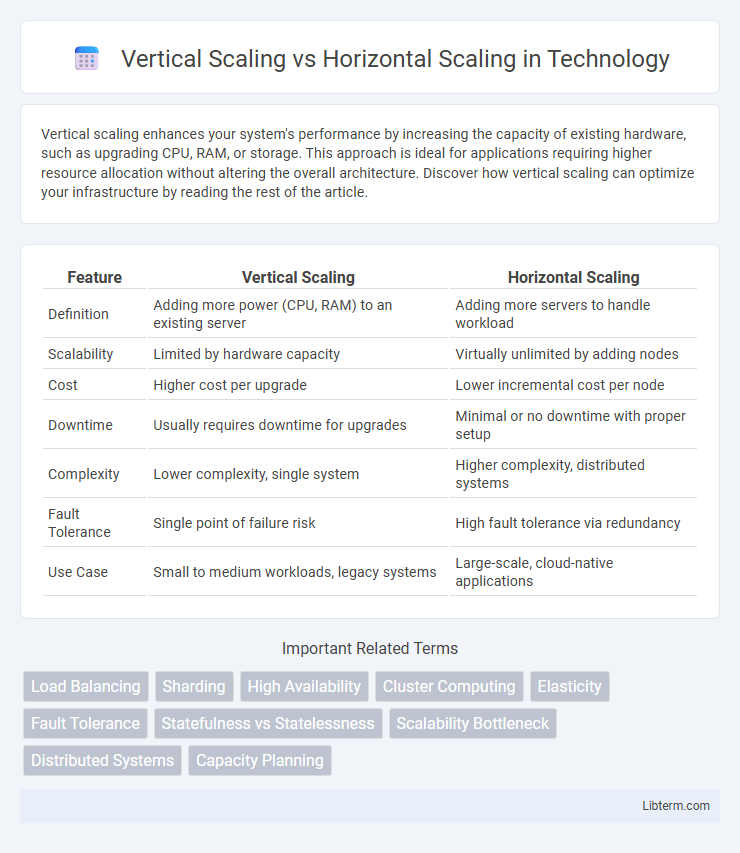Vertical scaling enhances your system's performance by increasing the capacity of existing hardware, such as upgrading CPU, RAM, or storage. This approach is ideal for applications requiring higher resource allocation without altering the overall architecture. Discover how vertical scaling can optimize your infrastructure by reading the rest of the article.
Table of Comparison
| Feature | Vertical Scaling | Horizontal Scaling |
|---|---|---|
| Definition | Adding more power (CPU, RAM) to an existing server | Adding more servers to handle workload |
| Scalability | Limited by hardware capacity | Virtually unlimited by adding nodes |
| Cost | Higher cost per upgrade | Lower incremental cost per node |
| Downtime | Usually requires downtime for upgrades | Minimal or no downtime with proper setup |
| Complexity | Lower complexity, single system | Higher complexity, distributed systems |
| Fault Tolerance | Single point of failure risk | High fault tolerance via redundancy |
| Use Case | Small to medium workloads, legacy systems | Large-scale, cloud-native applications |
Introduction to Scaling in IT Systems
Vertical scaling involves enhancing a single server's capacity by adding more CPU, RAM, or storage, maximizing its performance within physical limits. Horizontal scaling distributes workloads across multiple servers or nodes, improving system resilience and enabling seamless handling of increased traffic. Both strategies are essential in IT systems to optimize resource utilization and ensure scalability under varying demand conditions.
Defining Vertical Scaling
Vertical scaling, also known as scaling up, involves increasing a single server's capacity by adding more resources such as CPU, RAM, or storage to handle higher workloads. This method enhances the performance of an existing machine without changing the architecture, making it suitable for applications requiring strong consistency and low latency. Vertical scaling is limited by the maximum hardware capacity of the server, which can create a single point of failure in system design.
Defining Horizontal Scaling
Horizontal scaling, also known as scaling out, involves adding more machines or nodes to a system to increase capacity and handle higher loads. This method distributes workloads across multiple servers, enhancing fault tolerance and flexibility in cloud computing environments. It contrasts with vertical scaling, which improves performance by upgrading existing hardware components like CPU, RAM, or storage.
Key Differences Between Vertical and Horizontal Scaling
Vertical scaling involves increasing the capacity of a single server by adding more CPU, RAM, or storage, making it ideal for workloads requiring strong consistency and single-node performance. Horizontal scaling distributes workloads across multiple servers or nodes, enhancing fault tolerance and system availability while supporting large-scale, distributed applications. Key differences include cost efficiency, with vertical scaling often being more expensive per unit of resource, and scalability limits, as horizontal scaling can expand almost infinitely whereas vertical scaling faces hardware constraints.
Pros and Cons of Vertical Scaling
Vertical scaling enhances server performance by increasing CPU, RAM, or storage within a single machine, offering simplicity and reduced management complexity. However, it faces limitations in hardware capacity, higher downtime risks during upgrades, and a single point of failure. This approach suits workloads with predictable growth or legacy applications but struggles with massive traffic spikes or distributed processing demands.
Pros and Cons of Horizontal Scaling
Horizontal scaling enhances system performance by distributing workloads across multiple servers, improving fault tolerance and enabling seamless resource expansion. It reduces the risk of single points of failure but requires more complex management and synchronization between distributed nodes. Despite higher initial setup costs, horizontal scaling offers superior flexibility and resilience compared to vertical scaling.
Cost Implications of Scaling Approaches
Vertical scaling increases costs by requiring more powerful hardware or upgraded server components, often leading to higher upfront expenses and limited expansion capability. Horizontal scaling spreads the load across multiple cheaper machines, which can reduce individual unit costs but may increase overall infrastructure and management expenses due to added complexity. Cost efficiency depends on workload patterns, with horizontal scaling often favored for scalability and redundancy, while vertical scaling suits predictable, resource-intensive applications.
Performance and Reliability Considerations
Vertical scaling improves performance by increasing the capacity of a single server through enhanced CPU, RAM, or storage, but it risks downtime during hardware upgrades and faces limits in maximum resource expansion. Horizontal scaling boosts reliability by distributing workloads across multiple servers, allowing seamless failover and fault tolerance, which enhances system availability and load balancing. Performance gains in horizontal scaling depend on efficient data partitioning and network latency, making it suitable for distributed applications requiring high availability.
When to Choose Vertical or Horizontal Scaling
Vertical scaling is ideal for applications with predictable workloads and requires enhancing a single server's CPU, RAM, or storage to boost performance. Horizontal scaling suits distributed systems or cloud-native applications needing high availability and fault tolerance by adding more servers or instances. Choose vertical scaling for simplicity and cost-effectiveness in small-scale environments, while horizontal scaling is optimal for handling variable loads and ensuring redundancy in large-scale, high-traffic deployments.
Real-World Use Cases and Examples
Vertical scaling enhances performance by upgrading a single server's CPU, RAM, or storage, common in database servers like Oracle or SQL Server handling high transaction volumes. Horizontal scaling distributes workloads across multiple machines, as seen in cloud platforms like Amazon Web Services (AWS) or Netflix's microservices architecture, enabling seamless handling of traffic spikes and fault tolerance. Companies leverage vertical scaling for intensive computations and horizontal scaling for web applications requiring high availability and rapid expansion.
Vertical Scaling Infographic

 libterm.com
libterm.com